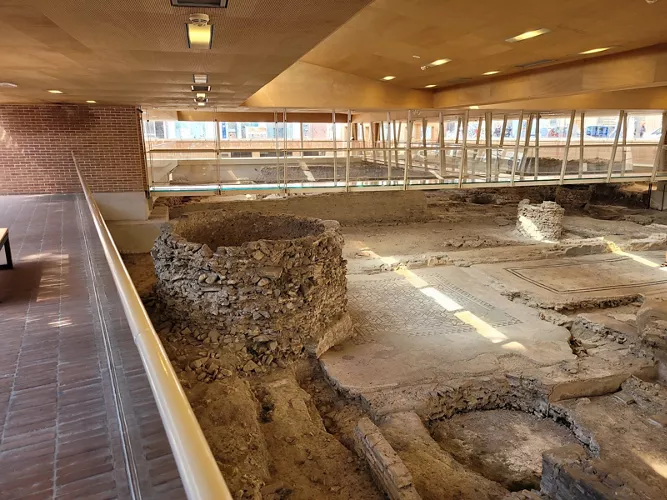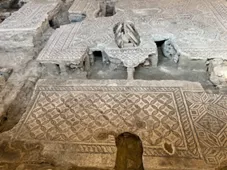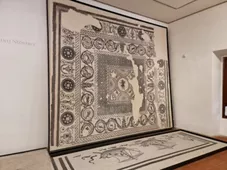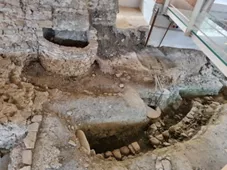



Overview
As the hub of Rimini's complex of cultural institutions, the Museum was established in 1990, uniting the city's existing civic collections, namely the archaeological collection, arranged by Luigi Tassini in 1844, and the Art Gallery, founded in 1924. Equipped with modern didactic and informative services, the museum houses material recovered from archaeological excavations, demolished buildings, deposits and donations, which tell the history of Rimini and its territory. The first nucleus of the civic collections was the Lapidarium, set up in 1981 in the inner courtyard of the College thanks to the work of Giancarlo Susini and Angela Donati. Composed of 68 inscriptions, ranging from the 1st century BC to the 4th century AD, it includes important funerary stele and ornamental basements, as well as architectural features and elements of great architectural interest, such as the administrative act concerning the restriction of the Roman roads promoted by Gaio Cesare. The archaeological section starts in the basement of the Jesuit College, where, in about forty rooms, the history of Rimini is traced, from the first evidence of Homo erectus found on the hill of Covignano to the foundation of Ariminum in 268 B.C. by the Romans and the development of the city in the Republican and Medieval Imperial age, and then continues with an in-depth look at the events that animated Rimini in the Imperial age, during the 2nd and 3rd centuries A.D.
In addition to the varied and enchanting selection of Roman mosaics, including the famous 'boat mosaic' from the domus of Palazzo Diotallevi and the 'Anubis' mosaic, there is also the extremely valuable polychrome glass-paste painting of fish and the richest surgical set of antiquity, both found in the nearby Surgeon's Domus, which has recently been turned into a museum and is the natural external continuation of the museum itinerary. The historical-artistic section, with around fifty exhibited works, allows the visitor to discover the evolution of Romanesque art from the fourteenth to the nineteenth century. The collection displays the famous school of the Trecento represented by Giuliano and Giovanni da Rimini and their students. The famous Pietà by Giovanni Bellini (1460) and the equally famous St. Vincent Ferreri altarpiece by Ghirlandaio (1494) refer to the Malatesta period, followed by works by Benedetto and Bartolomeo Coda, (such as Benedetto Coda's Madonna with Child and Saints, and Bartolomeo Coda's Last Supper) Bagnacavallo, Mastelletta, Salvator Rosa, Guercino, Cagnacci, Maffei, Piazzetta, Marchetti, Pittoni and Bigari.
Another section of the museum is dedicated to the nineteenth-century Rimini painter Guglielmo Bilancioni, while two other rooms house the drawings, paintings and graphic works of René Gruau, an artist who worked with the greatest fashion designers including Dior, Chanel, Givenchy and Balenciaga.
Other testimonies to local history include the nine tapestries decorating the municipal halls, woven in Antwerp in the 18th century to cartoons by A. Van Diepenberk; the famous 'saracen' used in jousts in the 17th century and the series of coats of arms (XVI-XVII century) from the most prestigious noble palaces of the city together with other stone fragments. The importance of Ariminum, one of the oldest cities founded by the Romans in Emilia Romagna, is well emphasised in the archaeological section, thanks to the succession of themes and materials that clearly narrate its relations with the mother-country Rome, the political-social system in place, its flourishing economy and equally flourishing production activities. Each piece of the exhibition is a testimony of the forms of craftsmanship of the time, a recreation of the domestic environments with their related furnishings, accessories and precious superfluities. The proposed objects come from the rich domus cittadine, and delineate the type of relationships between the port city and the sea and the traffic that links it to the East and Africa, revealing the forms of public and private worship to which the great urban architectural structures such as the amphitheatre are added. The reconstructions of the Domus del Chirurgo deserve an absolute highlight, showing the public a reproduction of some of the rooms as they were at the time: the medical study, the bedchamber, the dining room with its furnishings, the floors, the decorations, the furniture recovered during the archaeological excavation. The domus was in fact endowed with precious ornaments such as mosaics, intonations and colourful, precious and suggestive wall decorations. As has been said, the excavation operations have also allowed for the recovery of almost all the professional tools of the surgeon, almost all of which represent an incredible and fundamental material and cultural evidence of medical practice in antiquity. Overall, the domus constitutes a rare case of an outpatient clinic, combining the doctor's residence with spaces designed for the reception, examination and treatment of patients, as well as spaces dedicated to the preparation of medicines.